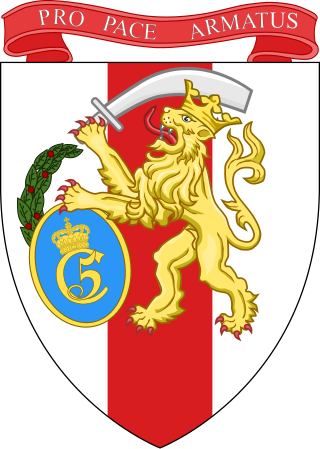
The Royal Danish Army is the land-based branch of the Danish Armed Forces, together with the Danish Home Guard. For the last decade, the Royal Danish Army has undergone a massive transformation of structures, equipment and training methods, abandoning its traditional role of anti-invasion defence, and instead focusing on out of area operations by, among other initiatives, reducing the size of the conscripted and reserve components and increasing the active component, changing from 60% support structure and 40% operational capability, to 60% combat operational capability and 40% support structure. When fully implemented, the Danish army will be capable of deploying 1,500 troops permanently on three different continents continuously, or 5,000 troops for a shorter period of time, in international operations without any need for extraordinary measures such as parliamentary approval of a war funding bill.

The Prince's Life Regiment was a Royal Danish Army infantry regiment. The motto of the regiment was "Gloria Finis".

Army Materiel Command, short "HMAK", was the Royal Danish Army's institution in all matters of materiel, including supply, maintenance and production. Anything from tanks to the sunglasses of troops or which kind of chocolate is in the field rations. It was a Level II command authority, directly under the Defence Command. In 2006 it was merged with the air force and navy materiel commands, creating the unified Defense Materiel Service, originally FMT and later known as FMI.

The Zealand Life Regiment was a Royal Danish Army infantry regiment. On 1 January 2001 it was disbanded and amalgamated into the Guard Hussar Regiment, which was moved from Næstved to Slagelse.

The Danish Life Regiment was an infantry regiment of the Royal Danish Army. On 1 January 2001 it was merged with the Zealand Life Regiment, into the Guard Hussar Regiment.

The Funen Life Regiment was an infantry regiment of the Royal Danish Army. On 1 November 1991 it was merged with the King's Jutlandic Regiment of Foot, into Slesvigske Fodregiment.

The Danish Artillery Regiment is an artillery unit of the Royal Danish Army, which was founded on 1 November 2005 when the two artillery regiments in Denmark, King's Artillery Regiment and Queen's Artillery Regiment were merged. The unit was disbanded in 2014 and revived in 2019.

The Schleswig Regiment of Foot is a Royal Danish Army infantry regiment. On 1 January 2001, the regiment was merged with the Queen's Life Regiment to form the Prince's Life Regiment. In 2018, it was announced that the regiment would be reestablished on 1 January 2019 as a light infantry battalion.

The Falster Foot Regiment was a Royal Danish Army infantry regiment. On 1 August 1976 it was amalgamated into the Danish Life Regiment, where four out of five battalions continued to exist until 1981.
The Ranks and insignia of Royal Danish Army follows the NATO system of ranks and insignia, as does the rest of the Danish Defence. The ranks are based around German and French military terms.

The 10th Regiment was a Danish Army infantry regiment. On 1 September 1961 it was merged with 8. Regiment and from 1 November 1961 the new regiment was known as Dronningens Livregiment. The name Feltherrens Fodregiment was never the official name, as the official name was 10. Regiment.

The Marine Regiment was the naval infantry of the Royal Dano-Norwegian Navy, and later an infantry regiment, established in 1672 by Christian IV and based at Glückstadt Naval Station.

The Jutlandic Regiment of Foot was a Royal Danish Army infantry regiment. On 1 November 1961, it was amalgamated with the King's Regiment of Foot, to create the King's Jutlandic Regiment of Foot.

The Queen's Life Regiment was a Royal Danish Army infantry regiment. On 1 January 2001, it was amalgamated with the Prince's Life Regiment.

The King's Jutlandic Regiment of Foot was a Royal Danish Army infantry regiment. On 1 November 1991, it was merged with the Funen Life Regiment, into Schleswig Regiment of Foot.
This article lists the structure of the Royal Danish Army in 1989 and in May 2020:

The Western Regional Command was the overall command of all Royal Danish Army units in Jutland and on Funen. It was split into four military regions, and was responsible for the regional defence. In 1990, the Regional Commands were disbanded and control was collected at the newly created Army Operational Command.

The Eastern Regional Command was the overall command of all Royal Danish Army units on Zealand. It was split into four military regions and was responsible for regional defence. In 1990, the Regional Commands were disbanded and control was collected at the newly created Army Operational Command.



















